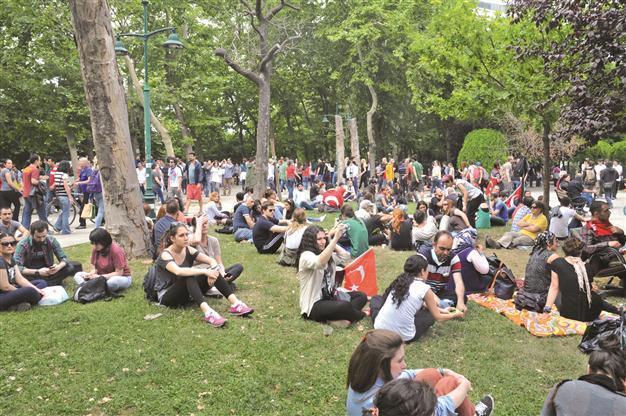Analysis: Turkey realizes strength with Occupy Taksim protest
ISTANBUL- Hürriyet Daily News

Demonstrators sit in Gezi Park, next to Taksim Square. DAILY NEWS photo, Hasan ALTINIŞIK
Waking up to a morning that lost its freshness to a bitter air filled with pepper gas, the mood in Cihangir, a district just near to Istanbul’s iconic Taksim Square, which has been witnessing popular unrest against a controversial urbanization project in the city, was replaced by deep silence after a night of clashes and rallies.
Confronting heavily equipped police forces all night, a few protesters were standing guard on the main Sıraselviler Street linking Cihangir to Taksim Square, while others just across the other side on İstiklal Avenue were trying to gain back their strength after a night-long watch in the middle of Istanbul’s heart. Outnumbering the now diminished protesters amid the ebbing enthusiasm due to low turnout, police forces have laid down a siege on the main gates to Taksim Square.
While the defiant protesters were still confident that more support would pour in, the security forces were thinking that their shift were finally nearing to an end. Hesitant to march against the police siege, protesters decided to wait until others to come for one of many attempts that they will make in the late afternoon later in the day. Then, it was an anxious wait lasting for hours.
This was the early Saturday morning atmosphere in the heart of Istanbul and the beginning of a day that would witness historic moments with tens of thousands of Occupy Taksim protesters. The protests started early in the week with a very low turnout against the demolition of a forgotten park, but what made it more popular was the brutal response of the police. Friday night was also historic for Istanbul as well, since the city has always been dominant for the entire country for different reasons and sentiments, but Saturday witnessed a rare moment for Turkey, which has not seen any popular unrest since the 1970s – a period that ended with a military junta.
The history of a metamorphosis What would become the Occupy Taksim protests had been bubbling beneath the surface in recent months as the ruling Justice and Development Party (AKP) staging political campaigns with its conservative agenda on different groups in Turkey. Taksim was a symbolic venue for the silent quarrel between the conservatives and others given its traditional significance as the city’s political and cultural center and due to its attractions that irk conservative values.
The passive aggression in the district started with the so-called “table operations” nearly two years ago as the side streets were stripped of tables serving alcohol. Then, it was put under a blockade with an urban project. While the AKP upped its campaign with its recent war on alcohol, like many others in the rest of the country, Istanbul’s locals felt threatened by an attack on a lifestyle different than what the government wished them to have. This was a reminder of feeling when the AKP first came to power nearly a decade ago, but now it was not only the old Republican “guards” of Turkey that were troubled by the actions of the authorities.
The growing discontent was the boost for the core Occupy Taksim protesters waiting for more hands in the middle of İstiklal on Saturday morning. What they just wanted was to let the AKP government know that their deeds also needed to be heard.
The protests united people with different motivations, ethnic backgrounds, political identities and religious beliefs. People at odds with each other in their daily life have been coming together when coming under heavy police attack while mocking them with slogans such as “Give us more tear gas.” Having similar characteristic with the so-called “Arab Spring” with its leaderlessness, the Occupy Taksim protests have turned into a political challenge to the AKP government, something that has been missing in Turkish politics for years. It could have more echoes, with senior Turkish officials signaling a U-turn over the controversial Taksim project.
Despite the high decibel and defiance, it would be still too early to make comparisons between the Occupy Taksimers and Arab Spring protesters while the labels, such as “Turkish Spring,” are still unripe for now. That being said, what the protests showed to both the country and its rulers was that the popular voice shall confront authority despite having long been weak.
